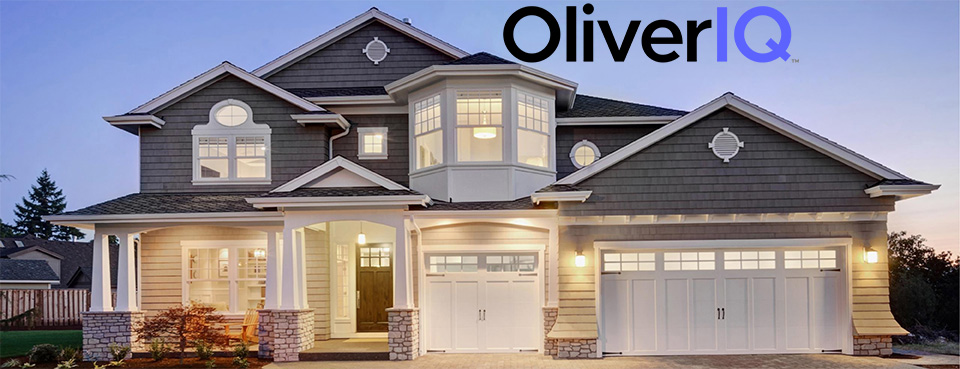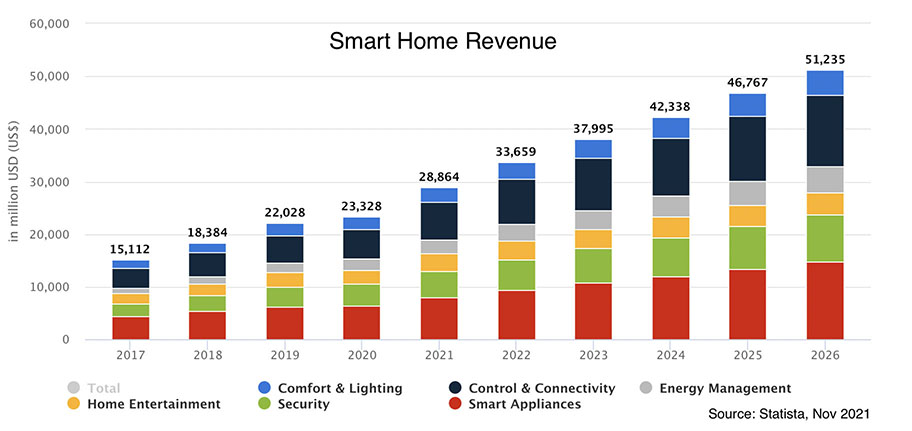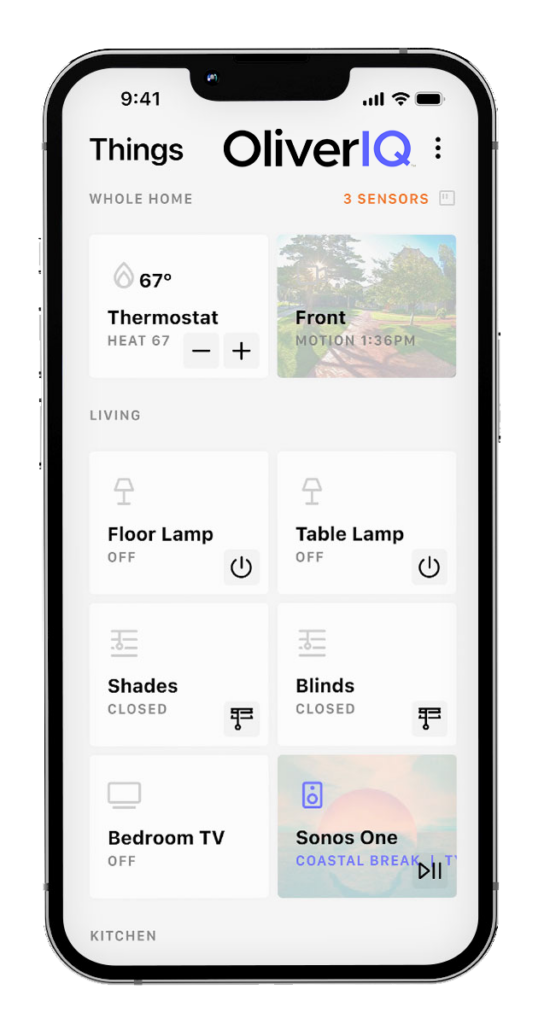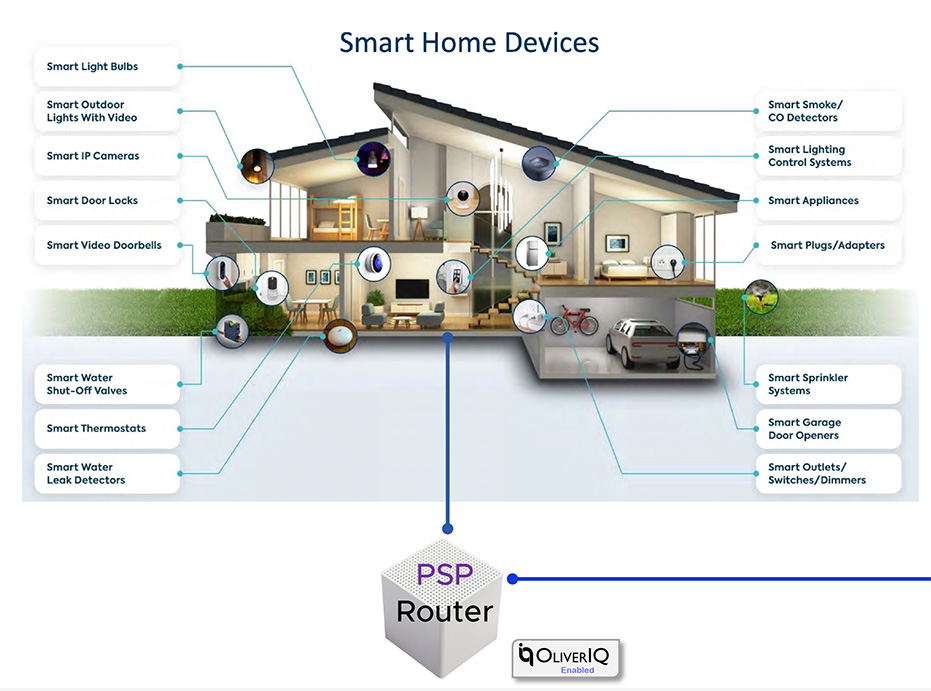
The ‘Intel Inside’ of the DIY Smart Home Industry
Launching today at CES 2024 is a new company of impressive pedigree that purports to offer Smart Home as a Service (SHaaS) through partnering with large national service providers -potentially scaling the category to a level not seen up to now. OliverIQ shared with members of the media their vision for an entirely new kind of multi-protocol, cloud-based, interoperability-enabling solution that just might change the face of the DIY Smart Home market.
See more on the bold thinking behind OliverIQ
When I’m presented with an opportunity to meet with a team launching an entirely new concept that is said to be a bold, potentially industry-shaking innovation…well, let’s just say that scenario is not as unusual as you might think. Usually, it happens about twenty or thirty times before every trade show (CES opens tomorrow). Innovators always believe their innovation will change the world. However, 99.99% of the time…they are wrong.
However, when told that the team launching this new, never-before-attempted business model (in our industry anyway) is the same group that founded Control4 back in 2003…NOW you’ve got my attention. When Control4 originally burst onto the scene, the home automation/custom integration landscape was a niche segment largely dominated by Crestron and AMX – two really good systems targeted to the wealthy upper 1%ers.
Control4 Expanded the Industry
Control4 changed all that, and legitimately made credible automation solutions accessible to a much broader consumer market. To be clear, even Control4 doesn’t address the mainstream market, as their systems can run north of $50K for a whole-home solution. But still, they brought automation to a much broader level – to a consumer that didn’t have access to the six or seven-figure top-end solutions where our industry started.
When we started Control4, our intent and thought was to try and bring home automation and the benefits of the Smart Home to the to the broader market. Not necessarily every person, but certainly the broader market than was at the time achievable by Crestron and AMX, who were nearly the sole providers of control systems.
Will West, OliverIQ CEO and Co-Founder
OliverIQ Seeks to Expand the Market Again
Now, as OliverIQ, this group of innovators is set to make an attempt to do it again, only this time on a much greater potential scale, working as the behind-the-scenes cloud-based back-end systems and operations provider of SHaaS to a wide assortment of national- and global-level “billion dollar” partners. Who will these providers be? I asked that question, but the company declined to answer. However, you should probably think along the lines of companies like Verizon, ADT, Vivint, AT&T, Comcast, Dish Networks, Home Depot, Lowe’s, etc.
What OliverIQ intends to do is to address, and maybe even turbocharge, the DIY (do it yourself) mass market consumer for smart home solutions. That may sound like an impossible accomplishment. After all, there are many popular DIY smart home products being used by consumers, such as the Nest Thermostat or Ring Camera – as well as a veritable plethora of smart speakers in millions of homes in America. But the reality is that these devices and the apps that operate them just don’t play well together on a DIY basis.

A Plethora of Device-Specific Apps
Consumers end up with their smartphones stuffed with a plethora of device-specific apps, lousy consumer-grade Wi-Fi, and systems that are constantly degrading as most end-users know nothing about all those device driver updates that they are not downloading and installing. This reality leads to user dissatisfaction as the systems are clunky to operate and start degrading almost immediately – eventually breaking. Run a Google Search on “smart home is dumb” and you will literally find 66 million pages (a real number, by the way) screaming about how dumb the smart home is.
With different popular devices offered by different providers on different protocols, it is nearly impossible to get all of these devices to work together at all…let alone seamlessly in a cohesive whole home system. Hell…it is a full-time job for today’s integrators – and they are typically working with higher-grade systems and solutions.
Moving from ‘Independent Control’ to Real ‘Automation’
Make no mistake, OliverIQ understands these challenges. Which is why they’re taking a different approach. And if everything they told me is true…they just might have the formula that will make the mainstream DIY consumer Smart Home…work!

As Will West told reporters in an introductory press presentation on OliverIQ recently, the myriad apps on consumers’ mobile devices are “independent control”…that’s not automation. “Automation is when you bring things together to create a better lifestyle, using the devices in your home working together,” West said. Clearly, the OliverIQ demo presented a degree of interoperability that was a stark contrast to those multiple, potentially dozens, of separate apps on consumers’ phones that spoke to one or just a few devices.
Just Exactly What is OliverIQ?
So, what is OliverIQ? Essentially, OliverIQ is a software company of deeply experienced Smart Home-savvy technologists who have developed three types of software that work together to solve the problems of the DIY Smart Home systems available today. These three software solutions include an in-the-field software/firmware device management solution (a hub), a brand-agnostic app, and a sophisticated cloud-based back-end solution that magically makes all of this work.
Particularly in the case of this software back-end, you get a sense of the uniqueness of its system. The back-end software supports multiple protocols allowing it to effortlessly interface with and address the expansive ecosystem of various devices, sensors, and switches out there. But that’s not the amazing part. The magic of this solution is that this cloud-based system fully integrates all of these devices from different systems to work together seamlessly as if part of one big happy family. And if the demo they showed us is honest, one can issue a series of serial commands, each based on a different protocol – even for the same device (Alexa, turn the upstairs switch on / Google, turn the upstairs switch off) – and everything operates perfectly…and quickly. It is impressive.

Helping Its Partners to Become ‘Home Automation Heroes’
Until now, no one company has been able to integrate and support the entire spectrum of smart home devices. OliverIQ helps its partners fill the gaps, becoming full-service home automation heroes in the eyes of their customers.
West
Upon further questioning, the executives clarified that they are not committing to operate every device on the planet. There may be some that are not included. CTO Smith told me, “We are not necessarily going to do every single device on the planet. But we’ll do most of them.”
Most of them, that is, that don’t work on Siri. OliverIQ currently does not include Siri-controlled devices in its system at the moment. “Apple’s a little harder to work with,” Smith told me. When I followed up to ask if Apple integration was forever out of the question, he told me, “No, we’re not saying that.”
A Couple of Potential Bugaboos
There are a couple of potential bugaboos – when issuing voice commands, you have to remember what system the device you’re addressing is based on… i.e. Alexa or Google. It is still necessary to use the appropriate wake words for each separate system. Also, the commands are executed in the cloud (ET phone home) so there is the worry of a lag in command execution.
But aside from these issues, however, this is the closest thing to nirvana I’ve seen in a consumer-grade DIY Smart Home system.
How Does SHaaS Work?
So how does Smart Home as a Service work? As mentioned previously, OliverIQ is partnering with large-scale system providers, such as ISPs, national security system brands, cable/satellite companies, major national retailers, telecom companies, and the like. These companies address an extensive consumer base with a tech product that they are already set up to sell and support. Some of these providers, the company noted, have thousands, or even tens of thousands of service vehicles spanning the nation. Now these providers will offer smart home systems to their customers – the end users – that will allow all of their smart home devices to work well together in a cohesive system, fast and reliably, thanks to the OliverIQ cloud-based system.
System operations and maintenance will be – depending on the contract with the main service provider – handled by OliverIQ, including executing driver updates, system upgrades, and more…either on a permission basis or in the background. Constantly monitoring and updating the system will allow it to work more reliably with fewer operational disruptions.
Offering Mainstream Consumers 24/7/365 Support
The company says that in partnership with national and global service providers, it will also offer comprehensive product support, unlimited online and phone support, in-home assistance, and security system monitoring. Truck rolls for in-home service will most likely be handled by the primary service provider. Service will be available on a 24/7/365 basis, a level of support that the vast majority of consumers have not seen from any Smart Home provider.
The unifying software that enables this interoperability will either reside in a service provider’s box – like a router, set top box, or security control panel, for example – or in an OliverIQ hub, which the company expects to sell for around $100.
Primary Service Providers to Pay OliverIQ a Per Subscriber Fee
For OliverIQ, these primary service providers will pay the company a monthly fee per subscriber. Given the scale of the companies with which they are looking to partner, a reasonable per subscriber rate could add up to big numbers quickly for the company.
What will the monthly subscription rate be? I asked that question and, again, the company declined to respond. However, CTO Eric Smith explained that the rate charged is up the the service provider to determine – not OliverIQ. But the executives led me to believe that the per user monthly rate should be fairly nominal.
Easy…Usable…Reliable, a Smart Home Market Igniter?
The goal of all of this is to make DIY Smart Home automation easy-to-acquire & install, effortlessly usable, and rock-steady reliable. And for those times something does go wrong, the end-user has just one number to call for phone, remote, or in-home service and support. CEO West and his team believe that this powerful combination might be the key to driving the DIY Smart Home sector to new and great heights.
With OliverIQ, we’re breaking down the barriers in the smart home. Our platform is designed to bring the convenience and lifestyle of a fully automated home to a broader audience at an affordale price point, with at-your-service technical support.
Eric Smith, OliverIQ Chief Technical Officer and Co-Founder
‘Intel Inside’ Marketing Strategy; Provider to be the ‘Hero’ of the End-User
The company says its goal is to make the top-level service provider the “hero” of its end-users. As such it will not be prominently pushing the OliverIQ brand. They will take a secondary role. Like when you purchase a new Dell laptop and it has an “Intel Inside” sticker on it – this will be the relationship between OliverIQ and its large-scale service provider client.
CEO West makes it clear that the company is not challenging the major providers of high-end home automation solutions, such as Crestron, Savant, and Control4. Rather, they believe that this unique business model will help them create a whole new class of Smart Home customers, and perhaps, raving fans.
We’re creating sticky relationships between homeowners and service providers. Customers won’t give up their smart home for a slightly lower monthly internet bill. With OliverIQ, today’s leading in-home service providers have a powerful platform for selling, servicing, and delivering high-demand solutions throughout today’s connected homes.
West
See OliverIQ at CES 2024
Launching this week at CES 2024, OliverIQ is currently in large-scale market testing now and expects to officially launch by Q2 of 2024. See the product and meet with company executives in Booth #51932 in the Venetian Expo.
To learn more about OliverIQ, visit oliveriq.com.







Leave a Reply